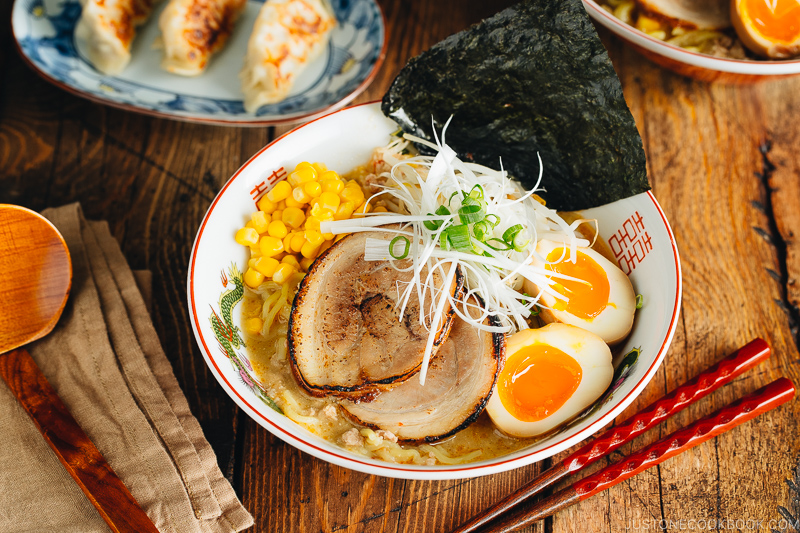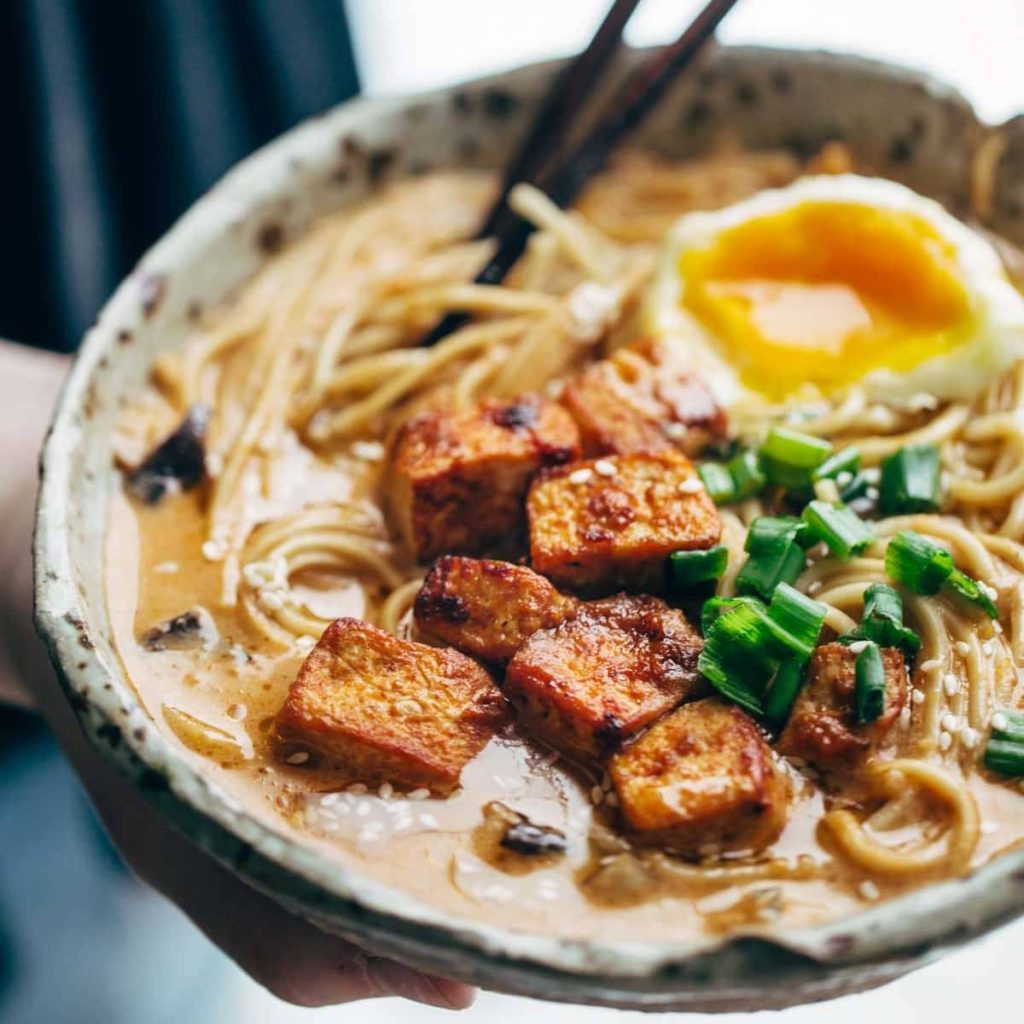Welcome to the world of culinary creativity with our exceptional Japanese Ramen Omelet recipe. Prepare to embark on a delightful journey that combines the beloved flavors of Japanese ramen with the comforting familiarity of an omelet. This innovative fusion dish brings together the umami-packed broth and noodles of ramen with the fluffy texture and versatility of an omelet.
Japanese ramen is renowned for its rich broth, toothsome noodles, and a variety of delicious toppings. The omelet, on the other hand, is a classic dish loved for its fluffy eggs and endless possibilities for fillings. In this recipe, we marry these two culinary traditions, resulting in a remarkable combination that will tantalize your taste buds.

Japanese Ramen Omelet Recipe
Equipment
- 1 bowl
- 1 pan
Ingredients
- 1/2 cup Onions
- 4 eggs
- Black pepper, to taste
- Salt, to taste
- 1/4 tsp Starch
- 4 packs ramen
- 1 slice Ginger
- 1 tbsp Soy sauce
- 1 tbsp oiloil
- Cilantro, as required
Instructions
- Take a large bowl.
- Add all the ingredients into the bowl.
- Make the egg mixture.
- Take a large pan.
- Heat a pan and then add the oil into the pan.
- Add the egg mixture on top when the oil heats up.
- Let the eggs cook from the bottom.
- Now slowly start to flip the egg.
- Dish out the egg when both the sides turn golden brown.
- Garnish the eggs by adding chopped cilantro on top.
- Your dish is ready to be served.
Video
Notes
FAQs
Q: Can I use any type of ramen noodles for the Japanese Ramen Omelet recipe?
A: Yes, you can use various types of ramen noodles for this recipe. Whether you prefer fresh, dried, or instant ramen noodles, feel free to use the type that is readily available to you. Adjust the cooking time accordingly based on the specific instructions for the noodles you choose.
Q: Can I add additional ingredients to the omelet filling?
A: Absolutely! The beauty of the Japanese Ramen Omelet recipe is its versatility. You can customize the omelet filling by adding ingredients such as sliced vegetables (e.g., mushrooms, bell peppers, or spinach), cooked meats (e.g., shredded chicken or sliced pork), or even extra toppings commonly found in ramen dishes (e.g., green onions, nori, or bean sprouts). Feel free to experiment and personalize the filling to your liking.
Q: How do I ensure that the omelet is fluffy and not overcooked?
A: To achieve a fluffy and tender omelet, it’s essential to cook it gently and avoid overcooking. Use medium-low heat and a non-stick pan or a well-greased skillet to prevent sticking. Allow the eggs to cook slowly, and when the edges start to set, gently lift and tilt the pan to allow the uncooked eggs to flow to the edges. Patience is key—avoid high heat and flipping the omelet too soon. Fold the omelet in half just before it fully sets, allowing the residual heat to finish the cooking process while maintaining its fluffiness.

Q: Can I make the ramen broth from scratch?
A: Yes, you can make the ramen broth from scratch for an authentic and flavorful experience. Simmering a combination of ingredients like bones, vegetables, and seasonings over a period of time will help develop a rich and aromatic broth. However, if you’re short on time, using pre-made ramen broth or instant ramen seasoning packets can still provide a delicious result.
Q: Can I make the omelet in advance and reheat it later?
A: While it’s best to enjoy the omelet immediately after cooking to maintain its texture and flavor, you can make it in advance and reheat it if needed. However, be aware that reheating may result in a slightly different texture, as the omelet could become firmer. To reheat, gently warm the omelet in a non-stick pan or in the microwave until heated through, being careful not to overcook it.
Q: Can I make a vegetarian or vegan version of the Japanese Ramen Omelet?
A: Yes, you can adapt the recipe to be vegetarian or vegan. For a vegetarian version, omit the meat-based toppings and choose vegetable broth instead of traditional ramen broth. Additionally, you can substitute eggs with a vegan egg substitute or tofu scramble to create a vegan-friendly omelet. Customize the recipe to suit your dietary preferences and enjoy a delicious plant-based version of the Japanese Ramen Omelet.
Cooking tips
Here are some useful tips to keep in mind when preparing the Japanese Ramen Omelet:
1. Cook the ramen noodles al dente: To ensure the noodles have the perfect texture in the omelet, cook them slightly underdone. This allows them to finish cooking when combined with the eggs, preventing them from becoming overly soft or mushy.
2. Drain and rinse the cooked noodles: After cooking the ramen noodles, be sure to drain and rinse them with cold water. This helps remove excess starch and prevents them from clumping together, ensuring they mix well with the eggs in the omelet.
3. Season the eggs: Before whisking the eggs, season them with a pinch of salt and pepper. This adds flavor to the omelet and enhances the overall taste of the dish.
4. Preheat the pan properly: It’s important to preheat the non-stick pan or skillet over medium-low heat before adding the egg mixture. This allows for even heat distribution and helps prevent the omelet from sticking to the pan.

5. Use gentle heat and slow cooking: To achieve a fluffy and tender omelet, cook it over medium-low heat. This slower cooking method ensures that the eggs cook evenly without browning too quickly.
6. Avoid overfilling the omelet: When adding the cooked ramen noodles and other fillings to the omelet, be mindful not to overfill it. Too many ingredients can make it difficult to fold and flip the omelet without it breaking apart. Aim for a balanced amount of filling that allows for easy folding and flipping.
7. Use a spatula to gently fold the omelet: When folding the omelet, use a spatula to lift one side and fold it over the other. Be gentle to avoid tearing or breaking the omelet. Allow the residual heat to finish cooking the omelet while it’s folded to ensure it remains fluffy and moist.
8. Garnish with toppings: Just like traditional ramen, the Japanese Ramen Omelet can be enhanced with a variety of toppings. Sprinkle sliced green onions, nori flakes, or sesame seeds on top of the omelet before serving to add visual appeal and extra flavor.
By following these tips, you’ll be well-equipped to create a delicious and visually appealing Japanese Ramen Omelet that perfectly balances the flavors of ramen and the satisfying texture of an omelet.
Serving suggestions
Here are some ideas on how to present and serve your Japanese Ramen Omelet for an enticing and satisfying dining experience:
1. Plating in a bowl: Transfer the omelet onto a deep plate or bowl to showcase its beautiful folded shape. Place it in the center of the plate, allowing it to be the focal point. Surround the omelet with a ladleful of hot ramen broth to create a comforting and visually appealing presentation.
2. Ramen bowl with garnishes: Serve the Japanese Ramen Omelet in a traditional ramen bowl. Place the folded omelet on one side of the bowl and carefully pour the flavorful ramen broth on the other side. Garnish with sliced green onions, a sprinkle of sesame seeds, and a sheet of nori for an authentic touch.
3. Sliced into bite-sized pieces: After cooking the omelet, slice it into bite-sized pieces for easier serving and sharing. Arrange the slices on a platter or individual plates and drizzle them with a small amount of ramen broth or a sauce of your choice. This allows everyone to enjoy their portion of the omelet with a touch of moisture and flavor.
4. Omelet wraps: For a fun and interactive serving option, provide a selection of fresh lettuce leaves or large cabbage leaves. Allow each person to fill the leaves with a slice of the omelet, some ramen noodles, and their favorite toppings. Roll the leaves into wraps and enjoy the combination of flavors and textures.

5. Customizable toppings bar: Set up a toppings bar with various condiments and garnishes, such as sliced green onions, bean sprouts, shredded nori, sesame seeds, and chili oil. Allow your guests to personalize their omelet by adding their desired toppings, creating a customized flavor profile.
6. Side dish with ramen accompaniments: Serve the Japanese Ramen Omelet as a side dish alongside a bowl of traditional ramen. This combination allows your guests to enjoy the omelet’s unique flavors alongside the classic ramen experience, providing a well-rounded meal.
Remember to provide chopsticks and spoons for easy consumption, allowing your guests to savor each bite of the Japanese Ramen Omelet. Encourage them to mix the omelet with the ramen broth and toppings for a delicious medley of flavors. Enjoy the delightful fusion of ramen and omelet in each mouthwatering bite!








